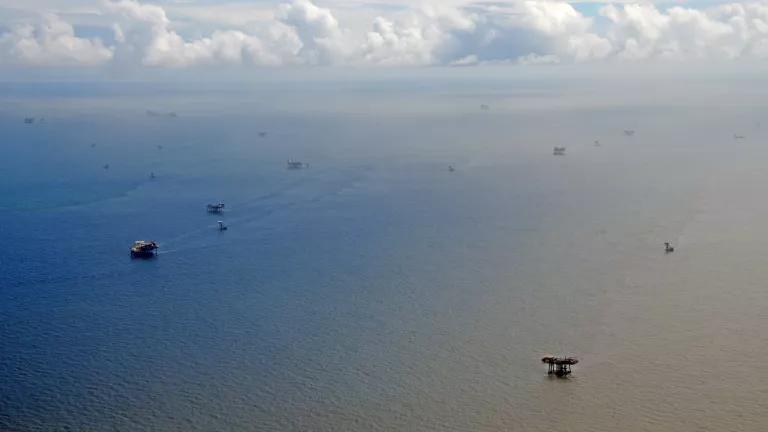
President Obama announced Friday that he will use his authority under the Antiquities Act to expand the Papahānaumokuākea Marine National Monument—an area of roughly 140,000 square miles that surrounds the Northwest Hawaiian Islands. This action will more than quadruple the size of the current protected area, expanding it to 582,578 square miles, and extend protections to the wildlife and historical, cultural and scientific assets that lie within the monument’s boundaries.
This action also creates the largest marine protected area on earth—in a place that could not illustrate more perfectly both the benefits of protecting ocean habitats and the pressing need to do so on a global scale.
Expanding Papahānaumokuākea will protect the sensitive ecosystems that exist within the monument—including coral reefs, seamounts, guyots (flat seamounts), and pelagic and deep-sea areas, which sustain a host of sea life, ranging from vital microscopic plankton to large sharks and whales. The expansion will also bring direct benefits to the diverse wildlife that relies upon these ecosystems, by creating a refuge for feeding, resting, reproducing and raising young.
Both deep-sea mining and commercial fishing will be prohibited within the monument, which increases protections for populations of corals, seabirds, sharks, tuna, whales, dolphins and sea turtles. Deep-sea mining threatens these species with chemical pollution, noise pollution and disruption of their fragile habitats. Commercial fishing poses a significant threat to marine species in the area. Longline fishing is currently the primary extractive threat in the expansion area, which hooks species such as sea turtles, sharks and seabirds (including both Laysan and black-footed albatross) as bycatch in the gear. Sharks are particularly threatened by the longline fishing that currently takes place in the area: more than one quarter million sharks—including species such as oceanic whitetip and silky sharks, whose populations have suffered steep declines—were caught as bycatch in the Northwest Hawaiian Islands over the last 25 years. By prohibiting these damaging activities within a larger area, the U.S. will increase protections for these and other species—both resident and highly migratory—and help support their conservation more effectively.

US Fish & Wildlife Service
Of equal importance, establishing large marine protected areas is a crucial element in building resilience to climate change and ocean acidification—and securing the health of the oceans, upon which all life on earth depends. The oceans produce the air we breathe, and they are a crucial source of protein for people all around the world. But the oceans are responding more quickly to climate change than our terrestrial environment is, with changes in ocean chemistry and warming temperatures already affecting the health, reproduction and distribution of marine species, from shellfish to sardines to seals. Establishing marine protected areas can build resilience in the face of climate change—and the waters of the Papahānaumokuākea Marine National Monument illustrate this perfectly. Here, the ocean is likely to be a temporary refuge for corals as the world warms, which makes this a perfect place to provide protection for the fish, sea turtles and marine mammals that may rely increasingly upon its waters.
Finally, the creation of this monument illustrates how diverse community interests can work together to protect important marine habitats around the world. This monument expansion is supported by native Hawaiians, fishermen, non-profit and religious organizations, community groups and scientists, among others. Drawing on their shared interest in the ecological, cultural and historical values of the area, these groups have focused national attention on the importance of protecting this area—and built the broad community support that will be important to implementing the new monument protections effectively in the years to come.
President Obama’s expansion of the Papahānaumokuākea monument makes a bold statement about the importance of protecting the oceans at a time when we need to act most urgently. Today, our oceans are in trouble, as industrial fishing—much of it illegal, unregulated and unreported—is driving the collapse of many fisheries around the globe, with cascading consequences for food webs throughout the sea. Industrial activities in the ocean—from oil and gas exploration and production to deep-sea-bed mining to shipping—are expanding and threatening both marine habitats and species, including deep-sea environments we have only just begun to explore and understand.

Establishing marine reserves is one of the most effective tools for securing the health of ocean ecosystems, yet less than two percent of the world’s oceans are protected today. We applaud President Obama for protecting the vital ecosystems of the Papahānaumokuākea Marine National Monument—and for highlighting the need for nations around the world to take bold, ambitious actions to protect their most important marine habitats.
And we hope that the U.S. will continue to be a leader in marine conservation, by extending similar protections to areas off the continental U.S., such as the New England Coral Canyons and Seamounts, and by continuing to support frameworks for creating marine protected areas on the high seas.



